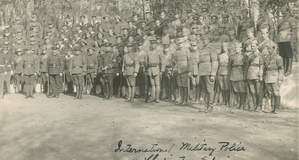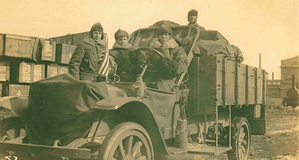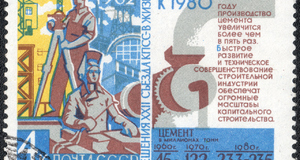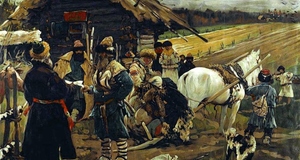The Polar Bear Expedition of 1918 - 1919: Interpreting Masculinity Through the Eyes of a Soldier
By
2016, Vol. 8 No. 10 | pg. 3/3 | « The OfficerA final imagining of masculinity comes from the officers who were present on the Expedition. This point of view is offered by a group of American sergeants who had collaborated together to produce a detailed account of company “A” in the 339th infantry. Again, the written standpoint is relatively unbiased, since the account demonizes neither the British nor the Russians. This is possibly due to the several opinions meshing together to form a relatively neutral outlook of the operation. Perhaps it was because they were simply more realistic about the expedition’s outcome. As stated before, in isolated outposts, it fell to the officer on site, like a sergeant, to take command of the group in the absence of central command.118 These men would have likely been the ones in charge of the front lines and must have realized the sheer difficulty in waging war against the Bolsheviks. In either case, the author(s) take a more technical tone toward the entire campaign. The book includes day to day activities and mild skirmishes analyzed in a careful, technical order. The most interesting part of these officers’ job was that they had to command their troops independently of central command. This idea of independent activity stands opposite to the new form of masculinity, which placed emphasis on working within a group. Yet, there were those of an older generation who preferred the idea of masculinity being tied to freedom rather than work and society. While past President Theodore Roosevelt reveled in the “soldier’s ethic” that stressed order and teamwork, Oliver Wendell Holmes Jr. protested against it. Holmes Jr. and others feared the possibility that talks of order and obedience to your “captain” would lead to a pseudo-fascist state in the U.S.119 Because the sergeants were likely older men or even veterans of the Spanish-American War, they may have thought of manhood as being the freedom to do what is needed. On the other hand, it is possible that this imagining of independence as masculine evolved out of need rather than ideology. The authors point out that the forces spread throughout south Russia had no contact with headquarters. If they had chosen to wait for orders, they would have likely been wiped out by the Bolsheviks or bad weather. 120While the authors seem to reject wartime notions of teamwork and obedience, they do seem to espouse masculine struggles their men endured. For example, in mid-late January, the south-most position for the expedition was spread between three villages: Ust Padenga, Visorka Goga, and Nijni Gora.121On the 19th of January, Nijni Gora was attacked by an onslaught of Bolshevik forces, described as being thousands of Bolshevik soldiers in camouflage charging 45 men and only one officer.122 While the entire area of the three villages came under attack, the authors record acts of heroism and sacrifice during the grueling battle that would last for a full seven days. One particular instance of this courage was displayed by American soldiers moving not only to supply ammo for the forces engaging the Bolsheviks, but also moving the wounded out on the return trip, something they were not required or ordered to do.123 Eventually, the forces had to retreat to the city of Shenkursk, located 18 miles north of the three villages.124 While some soldiers had believed that the city would be impenetrable, the officers inside the city were already planning on leaving due to the Bolsheviks moving to besiege the city on all sides. Not only were the 1,100 defenders outnumbered by 3,000 Bolshevik troops, but the Bolsheviks also had superior artillery on their side, allowing them to effectively outlast or destroy the city.125 The only way to escape the Bolsheviks was on an old logging trail, which would be extremely difficult to transverse. To aid passage, the British officers ordered the men to leave the wounded behind. While this seems heartless, this act points back to British sensibilities and imaginings of masculinity. If the Bolsheviks were capable of restraining themselves like proper men, the wounded soldiers would be cared for. The authors seem to confirm this ideology by pointing out that leaving those wounded soldiers behind for the enemy to tend to was common practice in civilized warfare.126 However, because the Bolsheviks were not trusted, the wounded were brought along. This was probably an intelligent move, considering the Russian imagining of masculinity focused only on nationalism and victory for the country at all costs. As long as the enemy was defeated, restraint did not matter. The maneuver is regarded as being extremely clever and well-executed, indeed, the force managed to escape without even being detected by the enemy.127 The authors, however, add that the men from those three villages to the south had to travel 80 miles over thirteen days; all while being attacked by overwhelming Bolshevik forces.128 Even in retreat, the American soldiers demonstrated incredible endurance and courage. This act logically represents the pinnacle of “doing the stumps,” although it is doubtful that the tired and cold soldiers felt alive doing it. It is an act that brings nothing to the participant, yet is done anyway despite the incredible amount of willpower needed to complete it. Still, the officers do show some ire to the British command for ordering the retreat from Shenkursk. While the authors note that the move has since become regarded as one of military genius, they also note that risked the lives of many American soldiers that were exhausted to the point of collapse.129 ConclusionAmerican forces were ultimately forced to withdraw from Russia, beginning in mid-April of 1919 when the spring thaw slowed Bolshevik advance.130 By July, all American forces had left Russia, leaving a total of 244 men dead with 305 wounded returns.131 White Russian and British forces were left to continue fighting, though eventually the British pulled out of Russia as well. The Bolshevik forces would go on to recapture Archangel, the former Expedition headquarters, on February 21, 1920.132 If there is something that can be shown about masculinity during the operation, it is that the American imaginings of this subject were much different than those held by Russians and British men. While both Russian and British mentalities about manhood had grown out of wartime experience, American masculinity held little in terms of nationalism. The subject of America comes up little in any of the four primary accounts. It only appears in two contexts. It could be used to describe the American soldiers themselves, as Cudahy describes the 310th Engineers and 337th Field Hospital Companies as “upholding the best in our American traditions.”133 The other context America appears in is homesickness. Anderson comments that when he and his company arrived in Russia that they “watched [an American flag over Archangel] with emotion; we had never realized before how beautiful those stars and stripes were and how much that flag meant to us, here in this apparently hostile land.”134 The idea of fighting for America does not come up often, if at all, in any of the memoirs. Again, this is most likely because the United States was not shaped as much by war or by a need to defend its sovereign territory. Any disputes the United States became involved with were literally oceans away. It might have been this lack of national mobilization for masculinity that caused it to be interpreted in different ways. Soldiers like Costello focused on both the struggle-based industrial masculinity and wartime teamwork masculinity, spinning tales of endless Herculean battles against the savage Bolsheviks. Given that these soldiers were the ones on the front lines of combat, Costello wanted to see that he and his comrades received their due in recognition for their actions. Chroniclers like Cudahy linked wartime masculinity to the Expedition in order to reveal the shortcomings of the British Empire. He describes how British “quarterbacks” cared little for the American “linemen” serving under them. Sergeants of company “A” collaborated to fill a book with the exploits of their men against impossible odds, ignoring wartime teamwork to focus on the struggles of the American soldiers. And medics like Anderson seemingly question aspects of masculinity by talking about health of the men who fought. Perhaps physical strength would not be at the heart of masculinity in the future. Although some assert that ideas of gender are specific and easy to understand, the complexity of how men interpreted it in the past suggests the opposite. Masculinity is not a fixed social law but something that is constantly being redefined and interpreted by those it affects. In fact, masculinity may be redefined again in the near future with the rising positive opinion of homosexuality. Since ideas of masculinity involved traditional family and therefore heterosexuality, like that of the British during WWI, it is possible that current ideas of masculinity will change according to the growing presence of homosexuality in the social climate. Ultimately though, the Polar Bear Expedition and other “small wars” remain relatively unknown in the realm of academia. It is likely that the few that are studied are not analyzed in anything beyond a political or military ideology. This in turn would cause the individual stories of the men who participated in the operation to be ignored, as the historians in question focus on national politicians and generals rather than the soldiers who were drafted. Men like Costello wanted their stories to be told; they wanted to be remembered for their actions and thoughts. They were the ones who made history happen, so it is only fair that historians do not forget their stories. ReferencesPrimary SourcesAnderson, Godfrey J. A Michigan Polar Bear confronts the Bolsheviks: A War Memoir: The 337th Field Hospital in Northern Russia, 1918-1919. Grand Rapids: William B. Eerdmans Publishing Company, 2010. Costello, Harry J. Why did we go to Russia? Detroit: H. J. Costello, c1920. {Accessed February 6th, 2013}. Cudahy, John. Archangel; The American War with Russia, by a Chronicler. Chicago: A.C. McClurg & Co., 1924. {Accessed June 12th, 2013} York, Dorothea, McCloskey, Edward J., Galloway, John F., and Culver, Harold C. The Romance of Company “A,” 329th Infantry A.N.R.E.F. Detroit: McIntrye Printing Co., c1923. {Accessed August 6th, 2013} Secondary SourcesBoot, Max. The Savage Wars of Peace: Small Wars and the Rise of American Power. New York: Basic Books, 2002. Brinkley, George A. The Volunteer Army and Allied Intervention in South Russia, 1917-1921; A Study in the Politics and Diplomacy of the Russian Civil War. Notre Dame: University of Notre Dame Press, 1966. Dawson, Graham. Soldier Heros: British Adventure, Empire, and the Imagining of Masculinities. New York: Routledge, 1994. Foglesong, David S. America’s Secret War against Bolshevikism: U.S. Intervention in the Russian Civil War, 1917-1920. Chapel Hill: The University of North Carolina Press, 1995. Gullace, Nicoletta. The Blood of our Sons: Men, Women, and the Renegotiation of British Citizenship during the Great War. New York: Palgrave Macmillan, 2002. Kimmel, Michael. Manhood in America: A Cultural History. New York: The Free Press, 1996. Mawdsley, Evan. The Russian Civil War. Boston: Allen & Unwin, 1987. Pettegrew, John. Brutes in Suits: Male Sensibility in America, 1890-1920. Baltimore: The John Hopkins University Press, 2007. Rotundo, E. Anthony. American Manhood: Transformations in Masculinity from the Revolution to the Modern Era. Basic Books, 1993. Sanborn, Joshua A. Drafting the Russian Nation: Military Conscription, Total War, and Mass Politics, 1905-1925. DeKalb: Illinois University Press, 2003 Stearns, Peter N. Be a Man! Males in Modern Society. New York: Holmes & Meier Publishers, Inc., 1979. Silverlight, John. The Victors’ Dilemma; Allied Intervention in the Russian Civil War. New York: Weybright and Talley, 1970. Endnotes1.) John Silverlight; The Victors’ Dilemma; Allied Intervention in the Russian Civil War. (New York: Weybright and Talley, 1970) 76. 2.) Max Boot. The Savage Wars of Peace: Small Wars and the Rise of American Power. (New York: Basic Books, 2002.) 214 3.) John Cudahy, Archangel; The American War with Russia, by a Chronicler. (Chicago: A.C. McClurg & Co., 1924), 30 4.) Harry J. Costello, Why did we go to Russia? (Detroit: H. J. Costello, c1920), 14 5.) Costello, 14 6.) Cudahy, 48 7.) Evan Mawdsley, The Russian Civil War. (Boston: Allen & Unwin, 1987) 46 8.) George A. Brinkley, The Volunteer Army and Allied Intervention in South Russia, 1917-1921; A Study in the Politics and Diplomacy of the Russian Civil War. (Notre Dame: University of Notre Dame Press, 1966) 76. 9.) Cudahy, 22 10.) David S. Foglesong, America’s Secret War against Bolshevikism: U.S. Intervention in the Russian Civil War, 1917-1920. (Chapel Hill: The University of North Carolina Press, 1995) 200 11.) Cudahy, 32 12.) Boot, 230 13.) Boot, 215 14.) Boot, 230 15.) Foglesong, 106 16.) Foglesong, 109 17.) Costello, 62 18.) Brinkley, 82 19.) Silverlight, 80 20.) Costello, 11 21.) Costello, 7 22.) Peter N. Stearns, Be a Man! Males in Modern Society. (New York: Holmes & Meier Publishers, Inc., 1979) 43 23.) Stearns, 44 24.) Stearns, 43 25.) Stearns, 44 26.) Stearns, 47 27.) Michael Kimmel, Manhood in America: A Cultural History. (New York: The Free Press, 1996), 119 28.) Costello, 7 29.) Costello, 15 30.) Costello, 18 31.) Cudahy, 41 32.) Costello, 16 33.) Costello, 52 34.) Dorothea York, Edward J. McCloskey, John F. Galloway, and Harold C. Culver. The Romance of Company “A,” 329th Infantry A.N.R.E.F. (Detroit: McIntrye Printing Co., c1923) 27. 35.) Costello, 67 36.) Costello, 19 37.) Joshua A. Sanborn, Drafting the Russian Nation: Military Conscription, Total War, and Mass Politics, 1905-1925. (DeKalb: Illinois University Press, 2003) 133 38.) Sanborn, 134 39.) Sanborn, 137 40.) Sanborn, 138 41.) Sanborn, 144 42.) Costello, 63 43.) Costello, 50 44.) Boot, 225 45.) Kimmel, 144 46.) Costello, 77 47.) Costello, 81 48.) E. Anthony Rotundo, American Manhood: Transformations in Masculinity from the Revolution to the Modern Era. (Basic Books, 1993), 226 49.) Kimmel, 135 50.) Kimmel, 136 51.) Costello, 51 52.) Costello, 76 53.) Sanborn, 142 54.) Sanborn, 159 55.) Costello, 40 56.) Brinkley, 108 57.) Costello, 39 58.) Costello, 40 59.) Sanborn, 138 60.) Sanborn, 149 61.) Costello, 9 62.) Mawdsley, 50 63.) Boot, 214 64.) Foglesong, 106 65.) Foglesong, 190 66.) Costello, 27 67.) York, 34 68.) Costello, 22 69.) Costello, 22 70.) Cudahy, 48 71.) Cudahy, 67 72.) Foglesong, 211 73.) Cudahy, 66 74.) York, 29 75.) Foglesong, 204 76.) . Foglesong, 110 77.) Cudahy, 63 78.) Cudahy, 62 79.) Cudahy, 71 80.) Silverlight, 57 81.) Silverlight, 55 82.) Cudahy, 74 83.) Foglesong, 201 84.) Cudahy, 63 85.) Cudahy, 28 86.) John Pettegrew, Brutes in Suits: Male Sensibility in America, 1890-1920. (Baltimore: The John Hopkins University Press, 2007) 244 87.) Pettegrew, 242 88.) Pettegrew, 248 89.) Nicoletta Gullace, The Blood of our Sons: Men, Women, and the Renegotiation of British Citizenship during the Great War. (New York: Palgrave Macmillan, 2002) 41. 90.) Gullace, 42 91.) Gullace, 47 92.) Gullace, 37 93.) Gullace, 46 94.) Gullace, 35 95.) Gullace, 46 96.) Rotundo, 227 97.) Gullace, 50 98.) Graham Dawson, Soldier Heros: British Adventure, Empire, and the Imagining of Masculinities. (New York: Routledge, 1994), 87. 99.) Anderson, 19 100.) Anderson, 19 101.) Anderson, 21 102.) Anderson, 48 103.) Anderson, 21 104.) Anderson, 105 105.) Anderson, 85 106.) Anderson, 20 107.) Kimmel, 127 108.) Anderson, 21 109.) Rotundo, 223 110.) Kimmel, 127 111.) Rontundo, 233 112.) Anderson, 63 113.) Costello, 26 114.) Anderson, 73 115.) Anderson, 141 116.) Pettegrew 248 117.) Pettegrew 252 118.) York, 29 119.) Rotundo, 236 120.) York, 28 121.) York, 57 122.) York, 77 123.) York, 80 124.) Boot, 221 125.) Boot, 221 126.) York, 99 127.) Boot, 222 128.) York, 109 129.) York, 102 130.) Boot, 225 131.) Boot, 225 132.) Boot, 226 133.) Cudahy, 50 134.) Anderson, 68 Suggested Reading from Inquiries Journal
Inquiries Journal provides undergraduate and graduate students around the world a platform for the wide dissemination of academic work over a range of core disciplines. Representing the work of students from hundreds of institutions around the globe, Inquiries Journal's large database of academic articles is completely free. Learn more | Blog | Submit Latest in History |


















